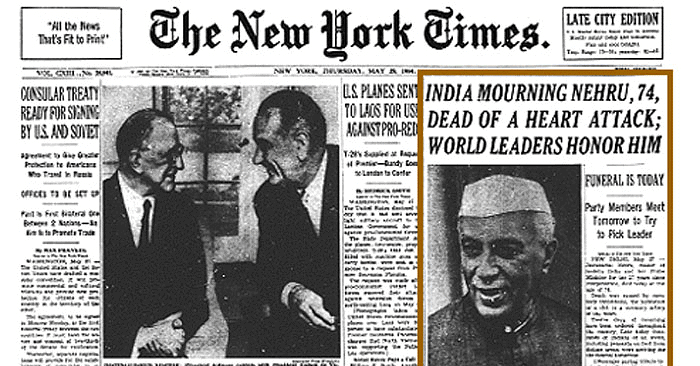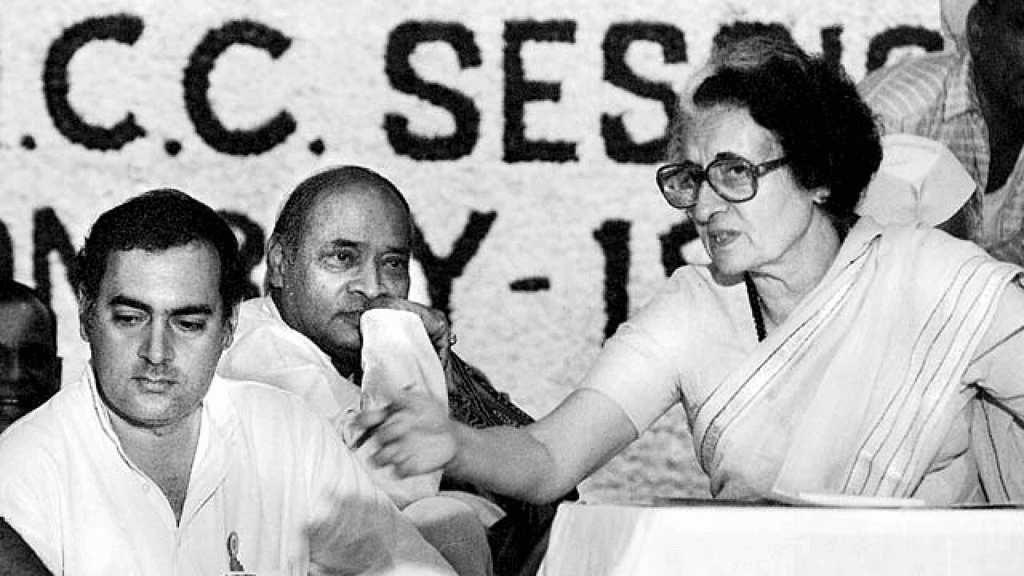Challenges to and Restoration of Congress System Class 12 Political Science
| Table of contents |

|
| Challenge of Political Succession |

|
| Fourth General Elections, 1967 |

|
| Split in the Congress |

|
| The 1971 Election and Restoration of Congress |

|
The Congress System, established in the aftermath of India's independence, faced challenges due to regional and ideological diversity, leading to fragmentation within the Indian National Congress. This fragmentation led to the emergence of alternative political parties, challenging Congress dominance. The restoration of the Congress System was attempted through strategies such as the Congress party's reorganization, alliances with regional parties, and ideological adaptation, aimed at maintaining its political hegemony.
Challenge of Political Succession
- Jawaharlal Nehru passed away in 1964 from a heart attack
- His death sparked much speculation about the usual succession question: after Nehru, who would lead?
- In a newly independent nation like India, this raised a more pressing question: after Nehru, what would happen?
- Many outsiders doubted whether India could maintain its democratic system without Nehru. There were fears that, like many other new nations, India might struggle with a democratic transition.
- A failure in this area could lead to military involvement in politics. Additionally, there were concerns about whether new leaders could tackle the numerous crises awaiting solutions.
- All the major leaders of the party consulted each other and decided to appoint Lal Bahadur Shastri as Prime Minister. K. Kamraj, the Congress party president, spoke with party leaders and members of Parliament, finding a consensus in favour of Shastri.
- He was unanimously elected as the leader of the Congress parliamentary party and became the next Prime Minister. Shastri, a non-controversial figure from Uttar Pradesh, had served in Nehru's cabinet for many years.
- In his last year, Nehru had relied heavily on Shastri. He was known for his simplicity and his strong commitment to principles.

From Nehru to Shastri
- Nehru’s death in 1964 caused much speculation regarding who would succeed him. He had been unwell for over a year, raising worries about India's democratic future. This situation led to a pressing question: what would happen after Nehru? Many outsiders also doubted if India's democracy could endure without him.
- Upon Nehru's passing, K. Kamraj, the president of the Congress party, consulted with party leaders and Congress Members of Parliament. There was a broad agreement in support of Lal Bahadur Shastri, who was chosen as the leader of the Congress parliamentary party and subsequently became Prime Minister.
- Shastri served as Prime Minister from 1964 to 1966. During his brief term, the nation faced two significant challenges: failed monsoons and drought led to a serious food crisis. Additionally, the country engaged in a war with Pakistan in 1965. Shastri's famous slogan ‘Jai Jawan Jai Kisan’ represented the nation’s determination to confront these difficulties.
- Shastri's time as Prime Minister ended suddenly on 10 January 1966 when he died unexpectedly in Tashkent, then part of the USSR. He was there to negotiate and sign an agreement with Muhammad Ayub Khan, the President of Pakistan, to end the war.
From Shastri to Indira Gandhi
- After sudden death of Lal Bahadur Shastri in 1966 there was an intense competition between Morarji Desai and Indira Gandhi for succession. Indira Gandhi was backed by senior party leaders.
- At that moment, the party's senior leaders, referred to as the Syndicate, chose to back Indira Gandhi, though their decision was not unanimous. They felt her lack of experience in administration and politics would make her reliant on them for advice and support.
- The leadership contest was settled through a secret ballot among Congress MPs, where Indira Gandhi won against Morarji Desai, gaining the backing of more than two-thirds of the MPs. This smooth transfer of power, despite the fierce competition, was viewed as a testament to the maturity of India's democracy.
Fourth General Elections, 1967
The year 1967 is seen as a significant moment in India's political and electoral history. In the time leading up to the fourth general elections, the nation experienced major shifts.
 Fourth General Elections
Fourth General Elections
Context of the Elections
- The year 1967 is seen as a significantyear in India's politics and elections.
- Before the fourth general elections, the nation faced a serious economic crisis due to failed monsoons, droughts, reduced agricultural output, severe food shortages, dwindling foreign exchange, and a fall in industrial production and exports.
- Two Prime Ministers had passed away in a short period, and the new Prime Minister, seen as inexperienced, had only been in office for under a year.
- One of Indira Gandhi's first actions was to devalue the Indian rupee, which many thought was influenced by the US.
- The next chapter will discuss how some communists broke away from the Communist Party of India (Marxist) to establish the Communist Party of India (Marxist-Leninist) and led armed struggles and peasant movements.
- The 1960s also experienced some of the most severe Hindu-Muslim riots since Independence.
Non-Congressism
- Opposition parties played a key role in organising publicprotests and putting pressure on the government.
- These opposition parties believed that IndiraGandhi's inexperience and the internalfactionalism within Congress gave them a chance to challenge its dominance.
- RamManoharLohia, a socialist leader, coined the term non-Congressism.
- The Grand Alliance lacked a clear political agenda. Indira Gandhi remarked that their only shared goal was to Remove Indira, whereas she promoted her own plan summarised in the slogan: Remove Poverty.
Electoral Verdict
- The fourth general elections for the LokSabha and StateAssemblies took place in February1967, amidst rising public dissatisfaction and political divisions.
- This was the first time the Congress faced voters without Nehru. The results were shocking for Congress at both national and state levels, with many political analysts referring to it as a ‘political earthquake’.
- The Congress did not secure a majority in the 1967 assembly elections, and half of Indira Gandhi's cabinet members lost their seats.
Coalitions
- The elections of 1967 brought into picture the phenomenon of coalitions.
- Since nosingleparty had got majority, various non-congress parties came together to form joint legislativeparties (called Samyukt Vidhayak Dal in Hindi) that supported non-congress governments.
Defection
- Defection means an electedrepresentative leaves the party on whose symbol he/she got elected and joins another party.
- The constant realignments and shifting political loyalties in this period gave rise to the expression ‘Aya Ram, Gaya Ram’.
Split in the Congress
After 1967 elections Congress saw split due to various differences:
What was Indira vs the ‘Syndicate’?
- Syndicate was a group of powerful and influential leaders from within the Congress.
- Indira Gandhi faced two challenges from syndicate to build her independence from the syndicate and to work towards regaining the ground that the Congress had lost in the 1967 elections.
Presidential Election, 1969
- The rivalry between the Syndicate and Indira Gandhi became prominent when the role of President of India was left empty in 1969 following the death of Zakir Hussain.
- Even though Mrs Gandhi had doubts, the Syndicate succeeded in nominating her long-term rival, N. Sanjeeva Reddy, who was then the Speaker of the Lok Sabha, as the official Congress candidate for the Presidential elections. In response, Indira Gandhi supported the then Vice-President, V.V. Giri, to stand as an independent candidate.
- Indira Gandhi introduced important policy changes, such as the nationalisation of fourteen major private banks. She framed the split as a conflict between socialists and conservatives, portraying it as a battle between the pro-poor and the pro-rich.
- The election resulted in the success of V.V. Giri, the independent candidate, while N. Sanjeeva Reddy, the official Congress candidate, was defeated. This outcome confirmed the division within the party.
- The Congress President expelled the Prime Minister from the party, asserting that her faction represented the true Congress. By November 1969, the Congress faction led by the Syndicate was termed Congress (Organisation), while Indira Gandhi's faction was known as Congress (Requisitionists). These groups were also referred to as Old Congress and New Congress.
The 1971 Election and Restoration of Congress
The Indira Gandhi’s Government recommended the dissolution of the Lok Sabha in December 1970 and the fifth general elections to the Lok Sabha were held in February 1971.
The Contest
- In the 1971 election, major non-communist and non-Congress opposition parties united to form an electoralalliance called the Grand Alliance.
- Indira Gandhi pointed out that the oppositionalliance had a single goal: Indira Hatao. However, the Grand Alliance lacked a clear political agenda, which was crucial in the elections.
- In contrast, she presented a positive agenda encapsulated in the well-known slogan: Garibi Hatao (Remove Poverty). This period also saw her actively promote existing land reform laws and propose additional land ceiling legislation.
- This slogan and the associated initiatives were part of her strategy to create a strong, independent political support base across the country. She emphasised the growth of the public sector, with the DMK as a key ally during this time.
- The ruling party formed an alliance with the Communist Party of India (CPI), which influenced the electoral dynamics further.
The Outcome and After Effect
- The outcome of the 1971 Lok Sabha elections was remarkable, as the Congress (R) – CPI alliance achieved greater success in both seats and votes than the Congress had in the first four general elections, particularly when compared to Congress(O).
- They collectively won 375 seats in Lok Sabha, securing 48.4 percent of the votes. Indira Gandhi’s Congress (R) alone won 352 seats with around 44 percent of the votes.
- In contrast, Congress(O), despite having many prominent leaders, managed to gain less than a quarter of the votes that Indira Gandhi's party received, winning only 16 seats.
- The Grand Alliance of the opposition ended up being a significant disappointment, with their total seats being fewer than 60.
Restoration
- In many ways, Indira Gandhi had revived the Congress system by altering its fundamental nature.
- Even though the new Congress was more popular, it lacked the ability to handle the tensions and conflicts that the Congress system was traditionally known for.
- As the Congress strengthened its position and Indira Gandhi gained unprecedented political authority, opportunities for people to express their democratic desires actually decreased.
- Popular unrest and mobilisation around issues like development and economic hardship continued to rise, leading to a political crisis that put constitutional democracy in the country at risk.
|
34 videos|308 docs|51 tests
|
FAQs on Challenges to and Restoration of Congress System Class 12 Political Science
| 1. What were the main challenges faced by the Congress Party during the Fourth General Elections in 1967? |  |
| 2. How did the split in the Congress Party affect the political landscape of India in the late 1960s? |  |
| 3. What were the key factors that contributed to the Congress Party's restoration in the 1971 elections? |  |
| 4. How did the events leading up to the 1971 elections reshape the Congress Party's strategies? |  |
| 5. What impact did the 1971 elections have on the future of the Congress Party in India? |  |





















